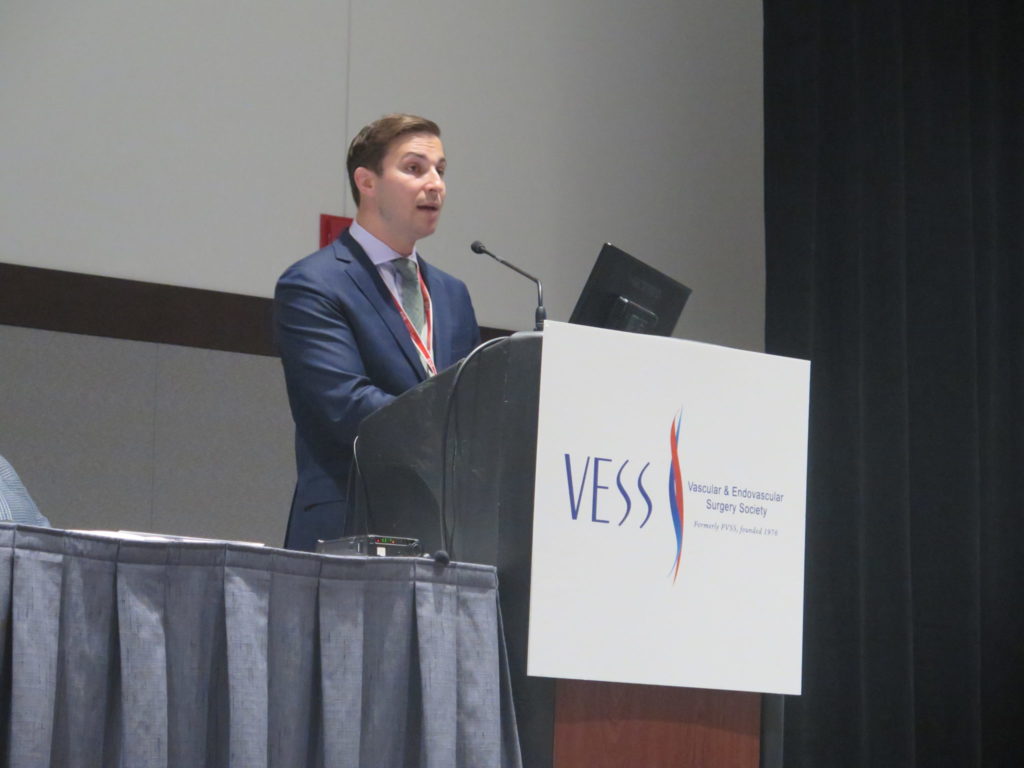
To accompany the growing importance of intravascular ultrasound (IVUS) as an adjuvant diagnostic tool when treating deep venous disease, a study sought to create an IVUS-based scoring system able to predict venous stent failure in the treatment of May-Thurner syndrome. The findings were revealed at the Society for Vascular Surgery Vascular Annual Meeting (VAM; 20–23 June, Boston, USA) by Steven D Abramowitz, MedStar Washington Hospital Center, Washington DC, USA.
The prediction of stent failure qualifies a step forward in both standardising and comparing outcomes for endovascular venous treatment. In turn, the authors suggest the use of the IVUS scoring system allows for the objective characterisation of iliac vein lesions, and may be able to predict lesions at high risk of reintervention.
The study took place within two collaborative institutions, analysing 118 patients diagnosed with May-Thurner syndrome, all of whom underwent IVUS-guided stent placement from April 2009 to May 2015. Patients included 86 (73%) females and 32 (27%) males with a mean age of 46 years (range: 17–83 years). All patients had C3-6 venous disease, a life expectancy of over five years, and were ambulatory.
Each patient was treated in a similar fashion, with ascending venography performed on both patient’s presenting with either C3-C6 disease, or acute DVT undergoing thrombolysis. Lesions were first treated, identified, then assessed at a post-operative window of six, 12 or 24 months. If the patient was found to have a stenosis on venous duplex, they either went for a CT venogram or ascending venogram, to confirm the presence of a new lesion.
An IVUS-driven scoring system was generated, containing seven categories for assessment. The first—and only category that allows for a three-point scoring system—was lesion presentation (non-thrombotic, acute, or chronic), followed by type of May-Thurner lesion (non-occlusive or occlusive).
The IVUS-driven categories consisted of: venous disease length (<180mm or >181mm), venous inflow compliance (presence or absence of respiratory variation) and iliocaval confluence disease involvement (present or absent). Lastly, iliocaval confluence stenting obligation (stented or spared) and presence of perivenous collaterals before and after stenting (non or resolved), were assessed and scored. Other than the first (scored 0, 1 or 2), the remaining six categories where scored 0 or 1, tabulated for each patient at the time of initial intervention.
Of all 118 patients that underwent treatment, 38 (32%) developed moderate (>50%) in-stent stenosis, required thrombolysis, or underwent additional stenting procedures and hence, were considered treatment failures. According to the authors, there is a lack of predictability in future outcomes for asymptomatic patients with occlusions, which meant their identification of a treatment failure in this case was very broad.
Eighty (68%) patients required no additional interventions and were considered treatment successes. The overall mean IVUS score for the entire patient population was 5.22 (±1.40). The mean IVUS score in the treatment failure cohort was 5.64 (±1.20) compared with a score of 4.67 (±1.47) in the treatment success group (p=0.0081).
When breaking down the results, Abramowitz suggested that no one category was responsible for a statistically significant difference in the outcome of the patients. Instead, a significant breaking point for the patients that had a composite score of greater than five was found. For example, if a patient had a composite score greater than four, relative risk of stent failure after two years was 1.6. However, a score of five would mean this relative risk at two years jumps to 2.4.
A multivariate analysis allowed the investigators to determine if this risk was associated with confounding factors, such as: age, gender or race. Yet, they found no statistically significant difference in terms of the outcome of the patients. Additionally, they looked at both presentation of disease (C3–C6 disease) and the patients underlying anticoagulant conditions. Again, these variables were not found to correlate with any statistical difference in outcome over the course period.
Due to the multi-factorial nature of stent-failure, Abramowitz concluded that the IVUS-based scoring system may have a role in predicting it, as higher composite scores were associated with increased stent failure, as well as an increased relative risk of it occurring. Therefore, a scoring system that can be used at the time of stent deployment enables the assessment of multiple factors regarding the vein and disease itself.
Regardless, Abramowitz noted that the IVUS-based scoring system needs further validation either in the form of retrospective or prospective examination, potentially by expanding into other institutions. During the audience discussion, further remarks for future improvements involved controlling for the type of anticoagulation in patients—which was not controlled for in this study. Nonetheless, comments were suggestive of how IVUS may help decrease the variability that iliac lesions are being treated with across different specialties, in turn optimising treatment strategies for the future.









